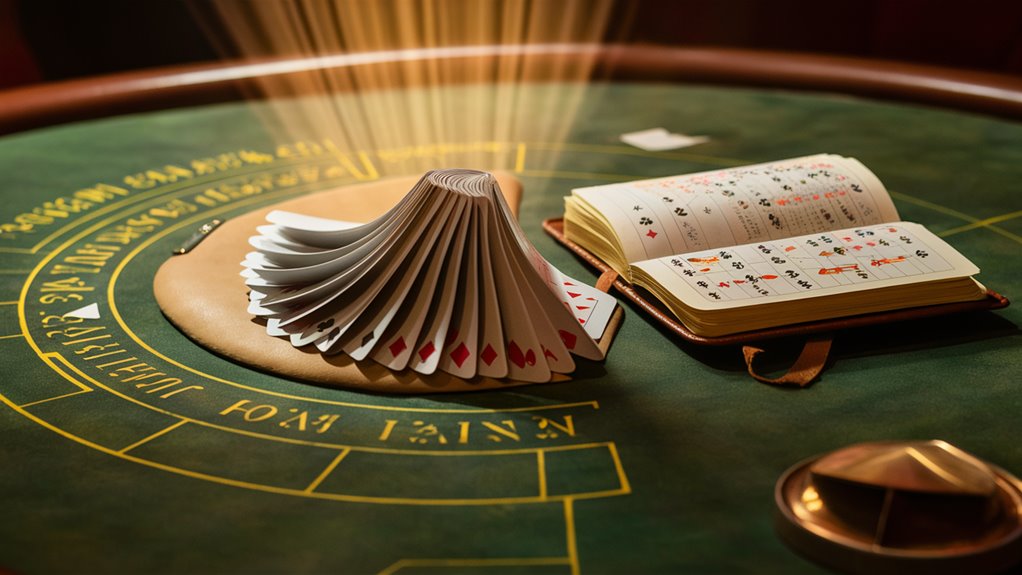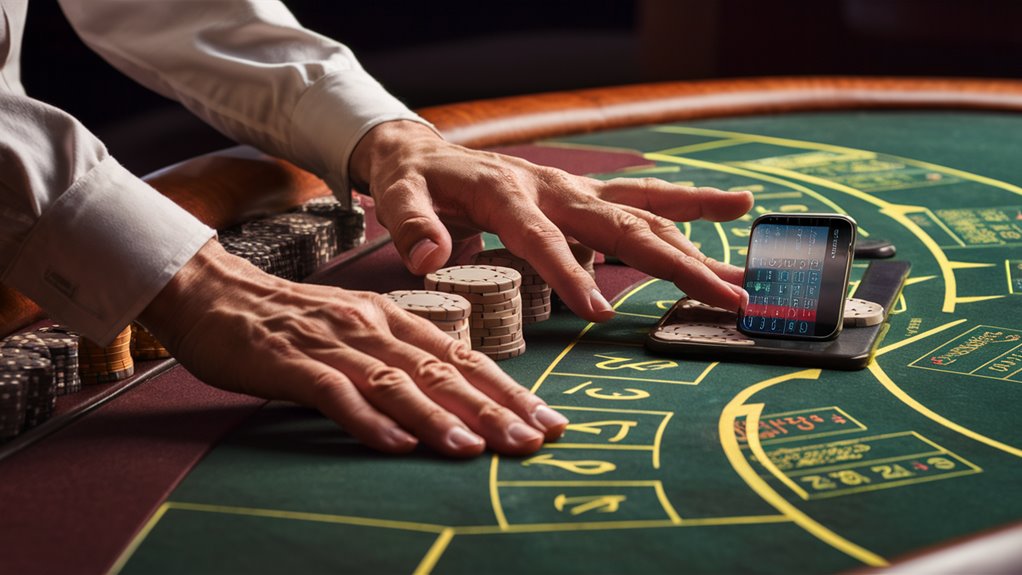Lotus Edge Blackjack: Advanced Strategy Meets Mindful Gaming
Lotus Edge Blackjack represents a groundbreaking evolution in advantage play strategies, seamlessly merging mindfulness techniques with data-driven gameplay. This sophisticated system, introduced by Galaxy Gaming in 2018, demonstrates a remarkable 2.14% house edge when properly executed.
Core Strategy Components
The foundation of Lotus Edge methodology rests on three key pillars:
- Mental Conditioning through controlled breathing and focused awareness
- Statistical Analysis incorporating true count variations
- Precision Monitoring of deck penetration metrics
Advanced Implementation
Players implementing the Lotus Edge system develop enhanced table presence while maintaining optimal concentration through:
- Meditative awareness during gameplay
- Variance analysis and probability tracking
- Emotional regulation techniques
Frequently Asked Questions
Q: What makes Lotus Edge Blackjack different from traditional systems?
A: Lotus Edge uniquely combines mindfulness practices with mathematical precision, creating a comprehensive approach to advantage play.
Q: What is the optimal deck penetration for Lotus Edge?
A: The system performs best with 75% or greater deck penetration, allowing for accurate statistical tracking.
Q: How long does it take to master Lotus Edge?
A: Proficiency typically requires 3-6 months of dedicated practice combining both mental and mathematical elements.
Q: What bankroll is recommended for Lotus Edge play?
A: A minimum of 200 units is recommended to properly implement the strategy and manage variance.
Q: Can Lotus Edge be used in online blackjack?
A: While primarily designed for live play, the system can be adapted for online gameplay with modified tracking methods.
The Origins of Lotus Edge

The Complete Guide to Lotus Edge Blackjack
Origins and Development
Lotus Edge emerged in 2018 as a groundbreaking proprietary table game developed by industry leader Galaxy Gaming.
This innovative blackjack variant represents a significant evolution in casino table gaming, combining traditional blackjack mechanics with advanced betting systems.
Game Mechanics and Features
The signature element of Lotus Edge lies in its sophisticated mathematical framework, featuring a precisely calibrated house edge of 2.14%.
The game’s modified paytable structure introduces the revolutionary Lotus Bonus bet, enabling players to win based on their initial two cards.
Strategic Implementation
The development process spanned 14 months of intensive refinement, focusing on optimizing rules and payout structures.
This meticulous attention to detail resulted in successful regulatory approval across major gaming jurisdictions, including Nevada, New Jersey, and Pennsylvania.
Market Positioning
The game’s branding strategy centers around the lotus flower symbol, strategically chosen to resonate with Asian gaming markets.
This cultural connection emphasizes themes of fortune and 먹튀검증 커뮤니티 prosperity, distinguishing Lotus Edge in the competitive casino gaming landscape.
Frequently Asked Questions
Q: What makes Lotus Edge different from traditional blackjack?
A: Lotus Edge features a unique Lotus Bonus bet and modified paytable structure while maintaining classic blackjack elements.
Q: What’s the house edge in Lotus Edge?
A: The game maintains a house edge of approximately 2.14%.
Q: Where can I play Lotus Edge?
A: Lotus Edge is available in licensed casinos across Nevada, New Jersey, and Pennsylvania.
Q: Who developed Lotus Edge?
A: Galaxy Gaming, a leading provider of casino table games, developed Lotus Edge.
Q: When was Lotus Edge introduced?
A: Lotus Edge was launched in 2018 after 14 months of development.
Mindfulness Meets Mathematical Strategy
The Ultimate Guide to Mindful Mathematical Strategy in Gaming
Mastering Advanced Strategy Through Mindful Mathematics
Strategic gaming excellence requires a sophisticated fusion of mindfulness techniques and mathematical precision that transcends traditional approaches.
The combination of calculated probability analysis and heightened mental awareness enables superior decision-making under high-pressure situations.
Mathematical Framework and Probability Analysis
The core mathematical component centers on tracking precise card distributions through an advanced counting methodology.
This system requires maintaining awareness of high-value versus low-value card ratios while executing optimal betting patterns based on true count variations and statistical deviations.
Mindfulness Integration for Enhanced Performance
Mental conditioning transforms theoretical mathematics into practical mastery through:
- Controlled breathing techniques between decisions
- Heart rate regulation for cognitive clarity
- Emotional trigger recognition to prevent strategy deviation
- Performance optimization during challenging sequences
Advanced Memory and Probability Training
Specialized concentration exercises enhance the capacity to process multiple probability calculations simultaneously.
This integration of mindful practice and mathematical analysis develops calculated intuition – the synchronized ability to make statistically optimal decisions while maintaining emotional equilibrium.
Frequently Asked Questions
Q: How does mindfulness improve mathematical decision-making?
A: Mindfulness techniques enhance focus, reduce stress, and improve working memory capacity for complex calculations.
Q: What’s calculated intuition?
A: Calculated intuition combines statistical analysis with emotional control for optimal decision-making under pressure.
Q: How long does it take to develop these skills?
A: Mastery typically requires 3-6 months of dedicated practice combining mathematical and mindfulness training.
Q: Can these techniques be applied to other strategic games?
A: Yes, these mindful mathematical principles are adaptable to various strategic gaming contexts.
Q: What’re the key benefits of this integrated approach?
A: Benefits include improved decision-making, enhanced emotional control, and superior mathematical processing ability.
Core Meditation Techniques

Essential Meditation Techniques for Mental Performance
Foundational Breathing Practices
Breath-focused meditation serves as the cornerstone of mental training, utilizing structured counting from one to ten during each inhale and exhale cycle.
This fundamental practice develops laser-sharp concentration and sustained mental focus, essential skills for complex cognitive tasks and strategic thinking.
Progressive Training Protocol
Begin with 5-minute mindful observation sessions, maintaining complete attention on breath sensations while seated comfortably.
When analytical thoughts arise, practice non-attachment awareness – acknowledging thoughts without engaging them before returning to the breath.
Gradually extend sessions to 15-minute durations, incorporating advanced visualization techniques and pattern recognition exercises.
Physical Integration Methods
Body scan meditation plays a crucial role in optimizing mental performance by systematically releasing physical tension.
Moving methodically from feet to head, this technique promotes emotional regulation and stress management. Practitioners report enhanced decision-making capabilities and maintained composure during high-pressure scenarios.
FAQ: Core Meditation Techniques
Q: How often should I practice meditation for optimal results?
A: Daily practice of 5-15 minutes is recommended for developing consistent mental focus.
Q: What’re the key benefits of breath-focused meditation?
A: Benefits include improved concentration, enhanced memory retention, and better emotional control.
Q: Can meditation improve decision-making abilities?
A: Yes, regular meditation practice strengthens mental clarity and strategic thinking capabilities.
Q: How long does it take to see results from meditation practice?
A: Most practitioners notice improvements in focus and composure within 2-4 weeks of consistent practice.
Q: What’s the best time of day to practice meditation?
A: Morning sessions are optimal, but consistency matters more than timing.
Advanced Statistical Decision Making
Advanced Statistical Decision Making in Gaming
Understanding Probability Fundamentals
Statistical analysis in complex gaming environments requires mastering both probability distributions and real-time variance calculations.
Successful players must maintain precise tracking of multiple probability streams while analyzing conditional probability patterns across extended gaming sessions.
Core Statistical Techniques
Frequency analysis forms the foundation of advanced gaming statistics.
Begin by mapping high-value versus low-value card distributions, then advance to sophisticated counting methodologies that incorporate deck penetration metrics.
Calculate true count values by analyzing the relationship between running counts and remaining deck quantity to establish accurate statistical advantages.
Advanced Probability Models
Implement Kelly criterion calculations alongside dynamic probability adjustments to optimize decision-making.
This mathematical framework enables precision-based betting strategies guided by concrete statistical models rather than intuition.
Track expected value deviations to identify prime betting opportunities while maintaining disciplined bankroll management protocols.
Real-Time Statistical Implementation
Combine advanced statistical tools with rapid decision execution.
Practice probability calculations under time constraints to simulate authentic gaming conditions.
Memorize critical probability thresholds for common scenarios to enable swift, mathematically sound choices.
Frequently Asked Questions
- What is deck penetration and why is it important?
- Deck penetration measures how many cards have been dealt, crucial for accurate probability calculations
- How does the Kelly criterion improve betting decisions?
- It optimizes bet sizing based on your edge and bankroll, maximizing long-term growth potential
- What are key probability thresholds to memorize?
- Focus on common scenarios’ basic probabilities and critical decision points
- How can players track multiple probability streams effectively?
- Develop systematic monitoring methods and practice regular mental calculations
- Why is real-time variance analysis important?
- It helps adjust strategies based on current conditions and statistical deviations
Real-World Application at Tables

Real-World Table Strategy Implementation
Optimal Table Positioning and Execution
Professional-level gameplay requires seamless integration of theoretical knowledge with practical mechanics.
The key to successful implementation lies in combining statistical awareness with precise physical execution while maintaining natural table presence.
Strategic positioning is fundamental – the third base position offers significant advantages:
- Maximum card visibility
- Extended decision-making time
- Optimal viewing angle for card tracking
- Natural betting sequence position
Advanced Gameplay Techniques
Consistent betting patterns remain crucial while incorporating subtle adjustments based on count variations.
Develop these essential skills:
- Smooth chip handling
- Natural card placement
- Pace control matching table rhythm
- Minimal movement patterns
Mental Tracking Systems
Implement advanced tracking methods through:
- Predetermined key cards
- Mental conversion points
- Non-verbal counting systems
- Casual player appearance
FAQ Section
Q: What’s the optimal table position?
A: Third base position provides the best combination of card visibility and decision time.
Q: How should betting patterns be managed?
A: Maintain consistency while making subtle adjustments based on count fluctuations.
Q: What’re key elements of proper table mechanics?
A: Smooth chip handling, natural card placement, and matching table rhythm.
Q: How can counting be done discreetly?
A: Use mental markers and predetermined key cards without verbal or written tracking.
Q: When should strategy adjustments be made?
A: Transition to basic strategy or exit during natural breaks when conditions become unfavorable.
